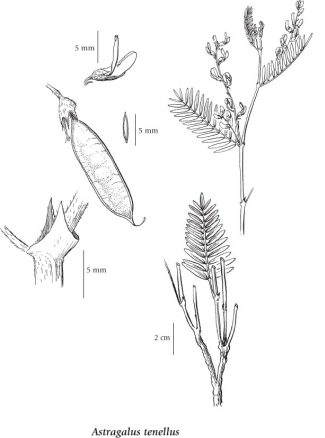Astragalus tenellus Pursh
pulse milk-vetch (looseflower milkvetch)
Fabaceae (Pea family)
Introduction to Vascular Plants
pulse milk-vetch (looseflower milkvetch)
Fabaceae (Pea family)
Introduction to Vascular Plants
Species Information click to expand contents
General:
Perennial herb from a thick taproot and knotty or short-branched stem-base; stems few to many in bushy clumps, ascending to erect, sometimes sprawling at higher elevations, 20-60 cm tall, branched, short-hairy with appressed, unbranched hairs.
Leaves:
Alternate, pinnately compound, 3-8 cm long, the stalks very short or lacking; leaflets 9 to 25, narrowly lanceolate to oblong, rounded at the tip, 0.8-2.5 cm long, finely appressed-hairy below, commonly glabrous above; stipules joined opposite the leaf stalks and clasping the stem, 3-6 mm long, the lowest papery and often blackish, the upper less strongly united.
Flowers:
Inflorescence a loose, axillary raceme of 4 to 20 pea-like flowers, the flowers at first ascending, later nodding, the racemes 3-10 cm long on short (1-4 cm) stalks; corollas 6-9 mm long, yellowish-white but sometimes pink-tinged, the keel purple-tipped, the banner slightly longer than the wings, which are 1-2 mm longer than the keel; calyces bell-shaped, appressed-hairy with black or white hairs, 2.5-4 mm long, the awl-shaped teeth 2/3 as long as the tube.
Fruits:
Pods, oblong, flattened, 7-18 mm long, drooping from the 1- to 5-mm long stalk, papery-membranous, glabrous, often mottled or stippled, net-veined when mature, 1-chambered.
Illustration click to expand contents

If more than one illustration is available for a species (e.g., separate illustrations were provided for two subspecies) then links to the separate images will be provided below. Note that individual subspecies or varietal illustrations are not always available.
Illustration Source: The Illustrated Flora of British Columbia
Ecology click to expand contents
Ecological Framework for Astragalus tenellus
The table below shows the species-specific information calculated from
original data (BEC database) provided by the BC Ministry of Forests and Range.
(Updated August, 2013)
The table below shows the species-specific information calculated from
original data (BEC database) provided by the BC Ministry of Forests and Range.
(Updated August, 2013)
| Site Information |
Value / Class |
||
|
Avg |
Min |
Max |
|
| Elevation
(metres) |
892 | 426 | 1560 |
| Slope
Gradient (%) |
24 | 0 | 90 |
|
Aspect (degrees) |
196 | 3 | 360 |
| Soil
Moisture Regime (SMR) [0 - very xeric; 4 - mesic; 8 - hydric] |
3 | 0 | 5 |
| Modal
Nutrient Regime
Class |
C | ||
| #
of field plots species was recorded in: |
123 | ||
| Modal
BEC Zone Class |
BG | ||
|
All BEC Zones (# of stations/zone) species was recorded in |
BG(51), BWBS(5), ICH(1), IDF(47), MS(4), PP(12), SWB(1) | ||
|
Source:
Klinkenberg 2013
|
|||
Habitat and Range click to expand contents
Mesic to dry grassy slopes and bluffs, sandy and gravelly flats, roadcuts and open forests from the steppe to lower subalpine zones; common in BC south of 57degreeN and east of the Coast-Cascade Mountains; N to S YT, E to MB and S to MN, NE, NM, NV, ID and MT.
Status Information click to expand contents
Synonyms click to expand contents
Synonyms and Alternate Names:
Astragalus tenellus var. strigulosus (Rydb.) F.J. Herm.
Homalobus tenellus (Pursh) Britton